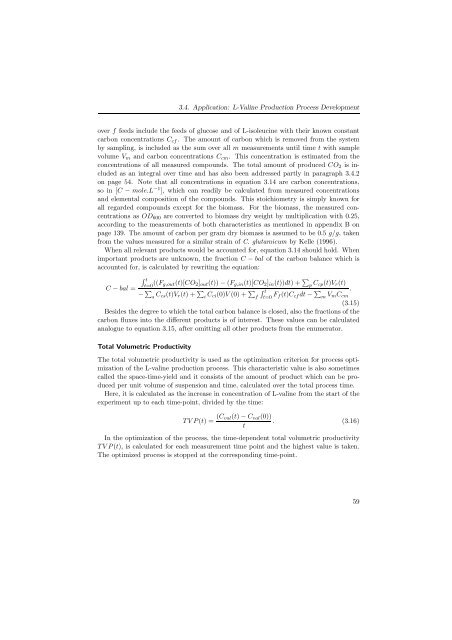Corynebacterium glutamicum - JUWEL - Forschungszentrum Jülich
Corynebacterium glutamicum - JUWEL - Forschungszentrum Jülich
Corynebacterium glutamicum - JUWEL - Forschungszentrum Jülich
Create successful ePaper yourself
Turn your PDF publications into a flip-book with our unique Google optimized e-Paper software.
3.4. Application: L-Valine Production Process Development<br />
over f feeds include the feeds of glucose and of L-isoleucine with their known constant<br />
carbon concentrations Ccf. The amount of carbon which is removed from the system<br />
by sampling, is included as the sum over all m measurements until time t with sample<br />
volume Vm and carbon concentrations Ccm. This concentration is estimated from the<br />
concentrations of all measured compounds. The total amount of produced CO2 is included<br />
as an integral over time and has also been addressed partly in paragraph 3.4.2<br />
on page 54. Note that all concentrations in equation 3.14 are carbon concentrations,<br />
so in [C − mole.L −1 ], which can readily be calculated from measured concentrations<br />
and elemental composition of the compounds. This stoichiometry is simply known for<br />
all regarded compounds except for the biomass. For the biomass, the measured concentrations<br />
as OD600 are converted to biomass dry weight by multiplication with 0.25,<br />
according to the measurements of both characteristics as mentioned in appendix B on<br />
page 139. The amount of carbon per gram dry biomass is assumed to be 0.5 g/g, taken<br />
from the values measured for a similar strain of C. <strong>glutamicum</strong> by Kelle (1996).<br />
When all relevant products would be accounted for, equation 3.14 should hold. When<br />
important products are unknown, the fraction C − bal of the carbon balance which is<br />
accounted for, is calculated by rewriting the equation:<br />
� t<br />
t=0<br />
C − bal =<br />
((Fg,out(t)[CO2]out(t)) − (Fg,in(t)[CO2]in(t))dt)+ �<br />
p Ccp(t)Vr(t)<br />
− �<br />
�<br />
s Ccs(t)Vr(t)+ i Cci(0)V (0) + � � t<br />
f t=0 Ff (t)Ccfdt − �<br />
m VmCcm<br />
.<br />
(3.15)<br />
Besides the degree to which the total carbon balance is closed, also the fractions of the<br />
carbon fluxes into the different products is of interest. These values can be calculated<br />
analogue to equation 3.15, after omitting all other products from the enumerator.<br />
Total Volumetric Productivity<br />
The total volumetric productivity is used as the optimization criterion for process optimization<br />
of the L-valine production process. This characteristic value is also sometimes<br />
called the space-time-yield and it consists of the amount of product which can be produced<br />
per unit volume of suspension and time, calculated over the total process time.<br />
Here, it is calculated as the increase in concentration of L-valine from the start of the<br />
experiment up to each time-point, divided by the time:<br />
TVP(t) = (Cval(t) − Cval(0))<br />
. (3.16)<br />
t<br />
In the optimization of the process, the time-dependent total volumetric productivity<br />
TVP(t), is calculated for each measurement time point and the highest value is taken.<br />
The optimized process is stopped at the corresponding time-point.<br />
59

















